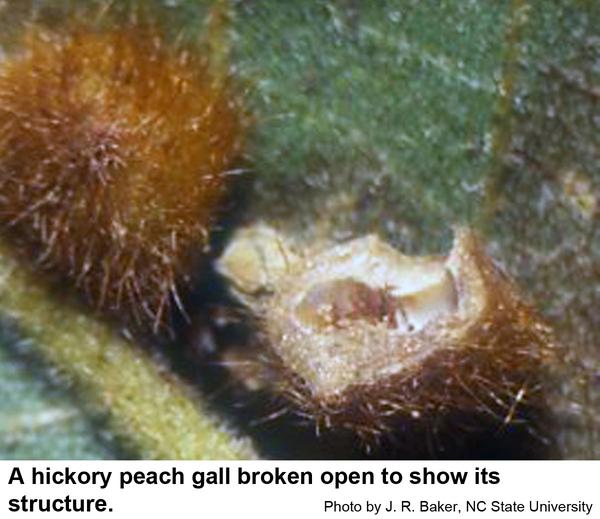Description and Biology
The hickory peach gall midge, Cariomyia persicoides, causes small, fuzzy, more or less spherical galls on the lower side of hickory leaves. These galls appear much like some of the leaf galls of cynipid gall wasps and psyllid gall makers, but when the galls are opened, a maggot is found inside each gall. These maggots have a peculiar "breast bone" structure that is visible through the integument typical of cecidomyiid larvae. Gall midge maggots drop from the galls to pupate in the soil in a thin, silken cocoon. The following year, a new generation of tiny, mosquito-like gnats emerges from the soil to lay eggs on the developing buds of hickories in early spring. This causes a chemical response in the leaf resulting in gall formation. This gall is rarely abundant enough to cause injury to the tree but some people find them to be an aesthetic problem. It is not unusual for insect populations to fluctuate drastically from year to year and place to place. Next year the galls may not show up at all. On the other hand, they may be worse!
Host Plants
Hickory is the only host reported for the hickory peach gall midge.
Residential Recommendations
By the time the galls are noticed, it is usually too late to apply an insecticide to kill the maggots inside the gall. If chemical control is desired for the next year, consider spraying the tree with some sort of contact/systemic pesticide such as acephate or imidacloprid just as the buds are breaking in early spring.
Other Resources
- A Catalog of Cecidomyiidae (Diptera) of the World, 4th Ed. Gagné, R. J. And M. Jaschhof. 2017. Syst. Ent. Lab, ARS, USDA, USNM NHB. 762 pp.
- Key to Gall Midges (A Resumé of Studies I-VII, Itonididae). Felt, E. P. 1925. New York State Museum Bulletin No. 257. 239 pp.
- Monograph of the Diptera of North America. Part II. Loew, H. 1867. Smithsonian Miscellaneous Collections, Vol. VI. Smithsonian Institution Pub.
- Extension Plant Pathology Publications and Factsheets
- Horticultural Science Publications
- North Carolina Agricultural Chemicals Manual
For assistance with a specific problem, contact your local N.C. Cooperative Extension Center.
This Factsheet has not been peer reviewed.
Publication date: May 27, 2020
Revised: April 27, 2020
Recommendations for the use of agricultural chemicals are included in this publication as a convenience to the reader. The use of brand names and any mention or listing of commercial products or services in this publication does not imply endorsement by NC State University or N.C. A&T State University nor discrimination against similar products or services not mentioned. Individuals who use agricultural chemicals are responsible for ensuring that the intended use complies with current regulations and conforms to the product label. Be sure to obtain current information about usage regulations and examine a current product label before applying any chemical. For assistance, contact your local N.C. Cooperative Extension county center.
N.C. Cooperative Extension prohibits discrimination and harassment regardless of age, color, disability, family and marital status, gender identity, national origin, political beliefs, race, religion, sex (including pregnancy), sexual orientation and veteran status.



